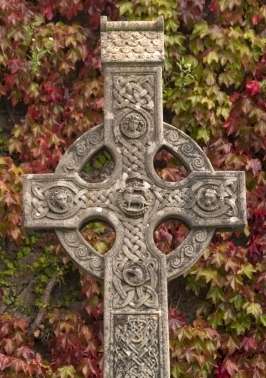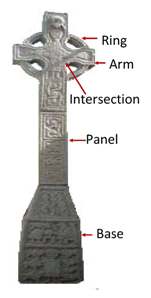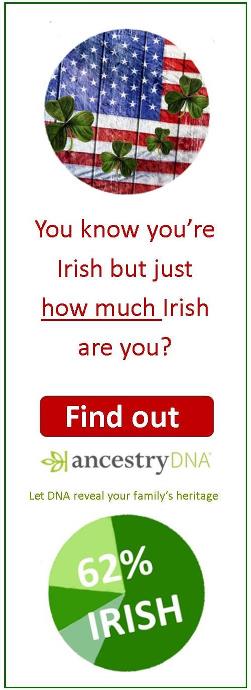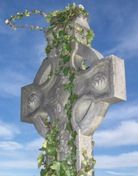- Home ›
- Irish symbols ›
- Celtic Cross
The Irish Celtic Cross


The Irish Celtic Cross is a symbol that conjures up all the mystery of the Dark Ages. It is also a popular symbol of faith, whether the belief is pagan, christian or of any other religion. But perhaps it is most widely known as a powerful symbol of Irish heritage.
Its name came about simply because most of the earliest examples were found in the Celtic island of Ireland. They have also been found in other Celtic lands in southwest England, in Scotland and in Wales but they became popularly associated with Ireland because they are most numerous on the island.
Catholics usually refer to this style of cross - with a ring connecting the four sections - as the Irish Cross. To be as inclusive as possible, I'm going to refer to this style as the Irish Celtic Cross.
The history of the Irish Celtic Cross
It is not known exactly when the Celts first started erecting monumental stones. Nor is it clear exactly why they developed this habit. Certainly it was a relatively common practice long before Christianity arrived in Ireland, and Celtic historians suggest that the basic shape of these crosses may have been meant to represent trees, which they held in great reverence.
When Christian missionaries arrived in the 5th century they were keen not to upset the early pagan Celts. Cleverly, they merged Christian cross and Celtic cross designs, to make the new religion more readily acceptable and 'familiar'.
According to a popular legend, St Patrick himself was responsible for the design when he combined a Christian cross symbol with the sun, one of the most important and ancient Celtic symbols of life.
As is the way of most legends, there is no evidence that this really happened. Rather the contrary. Archaeological discoveries suggest the design of the cross predates St Patrick's arrival. But it was, nonetheless, Christian monks who were responsible for most of the crosses that remain standing.
Three types of Irish Celtic cross
The cross falls into three categories:
When the cross is clearly an ornamental or ceremonial standing stone AND its at least 800 years old, it's called a Celtic High Cross.
 The Irish Celtic cross memorial in Kilkerranmore graveyard, County Cork.
The Irish Celtic cross memorial in Kilkerranmore graveyard, County Cork.When the cross is clearly a standing stone AND it dates from the 12th century onwards, it's original purpose was probably as a boundary or territorial marker. These are correctly called Celtic crosses, but they are not High crosses, even if they are quite tall.
When the cross marks a grave or is some other type of memorial, you can be quite sure it is a relatively modern. The phenomenon of Irish Celtic cross memorials dates from only the 1860s, when they became de rigeur for Dublin's fashionistas.
 Irish Celtic Cross memorial in Kilkerranmore, County Cork.
Irish Celtic Cross memorial in Kilkerranmore, County Cork.The cross falls into three categories:
When the cross is clearly an ornamental or ceremonial standing stone AND its at least 800 years old, it's called a Celtic High Cross.
When the cross is clearly a standing stone AND it dates from the 12th century onwards, it's original purpose was probably as a boundary or territorial marker. These are correctly called Celtic crosses, but they are not High crosses, even if they are quite tall.
When the cross marks a grave or is some other type of memorial, you can be quite sure it is a relatively modern. The phenomenon of Irish Celtic cross memorials dates from only the 1860s, when they became de rigeur for Dublin's fashionistas.
Irish Celtic cross designs
In the absense of any more obvious clue, the relative antiquity of a Cross can be guessed by studying certain features.
In the oldest stones, the arms of the cross do not usually extend outside the ring. In later stones, they do. The Panel of the very oldest stones usually contain ancient Celtic symbols, geometric or nature symbols, whereas later and medieval crosses are decorated with biblical scenes. Modern stones have returned to geometric symbols.
Spiral and key patterns were typical of Celtic cross art and were borrowed from Celtic metalwork. In the photos above, you will notice five circular features (known as bosses) on the ringed section of the cross. These, together with the ring, are thought to represent the rivets of the Celtic warrior's shield.

Although not essential to the design, they remain one of the most common Irish Celtic symbols and a frequent feature of these structures.
In the absense of any more obvious clue, the relative antiquity of a Cross can be guessed by studying certain features.

In the oldest stones, the arms of the cross do not usually extend outside the ring. In later stones, they do. The Panel of the very oldest stones usually contain ancient Celtic symbols, geometric or nature symbols, whereas later and medieval crosses are decorated with biblical scenes. Modern stones have returned to geometric symbols.
Spiral and key patterns were typical of Celtic cross art and were borrowed from Celtic metalwork. In the photos above (but not to the right), you will notice five circular features called bosses on the ringed section of the cross. These, together with the ring, are thought to represent the rivets of the Celtic warrior's shield.
Although not essential to the design, they remain one of the most common Irish Celtic symbols and a frequent feature of these structures.
Find out more
Today, this ancient symbol seems to be everywhere in Ireland. Not just out in the countryside or in graveyards and cemeteries but in many logos and advertising formats, on t-shirts, souvenir coffee cups, jewellery and key-rings, and, in perhaps the most extreme way to broadcast your Irish genealogical heritage, in the form of Irish cross tattoos.



